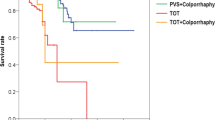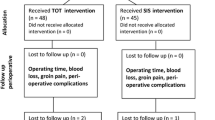Abstract
Purpose: To compare short-term results of autologous pubovaginal sling and synthetic transobturator (TOT) SAFYRE sling in the treatment of female stress urinary incontinence (SUI). Methods: Twenty women referred for surgical treatment of SUI were assigned randomly to autologous pubovaginal sling or synthetic TOT sling. Inclusion criteria were primary treatment of SUI and urodynamic study showing SUI without detrusor overactivity. Pre- and postoperative quantification of the severity of incontinence was done by pad test and a validated questionnaire (King’s Health Questionnaire). Results: There were no differences in patients’ mean age, parity, body mass index, rate of postmenopausal state, pelvic floor defects and mean Valsalva leak point pressure in the preoperative urodynamic study. Mean operating time (21.1 ± 3.8 vs. 69.5 ± 23.7 min; P<0.001) and hospital stay (28.8 ± 8.4 vs. 44.4 ± 5.8 h; P<0.001) was shorter in the TOT than the autologous group. The postoperative pad test (39.4 ± 12.5 vs. 8.4 ± 5.2 g; P=0.01) and the absent in the improvement in the quality of life were significantly higher in the TOT group. Conclusion: Our initial results suggest that the synthetic TOT technique had worse effectiveness for treating female SUI compared to autologous pubovaginal sling.
Similar content being viewed by others
References
Bidmead J, Cardozo L (2000) Sling techniques in the treatment of genuine stress incontinence. BJOG 107:147–156
Aldridge AH (1942) Transplantation of fascia for the relief of urinary incontinence. Am J Obstet Gynecol 44:398–411
Silva-Filho AL, Triginelli SA, Noviello MB (2003) Pubovaginal sling in the treatment of stress urinary incontinence for urethral hypermobility and intrinsic sphincteric deficiency. Braz J Urol 29(6):540–544
Chaikin D, Rosenthal J, Blaivas G (1998) Pubovaginal fascial sling for all types of stress urinary incontinence: long term analysis. J Urol 160:1312–1316
Delorme E (2001) Transobturator urethral suspension: mini-invasive procedure in the treatment of stress urinary incontinence in women. Prog Urol 11:1306–1313
Versi E, Orrego G, Hardy E (1996) Evaluation of the home pad test in the investigation of female urinary incontinence. British J Obstet and Gynaecol 103:162–167
Norris JP, Breslin DS, Staskin DR (1996) Use of synthetic material in sling surgery: a minimally invasive approach. J Endourol 10:227–230
Ulmsten U, Johnson P, Rezapour M (1999) A three-year follow up of tension free vaginal tape for surgical treatment of female stress urinary incontinence. BJOG 106:345–350
Soulie M, Cuvillier X, Benaissa A (2001) The tension-free transvaginal tape procedure in the treatment of female urinary stress incontinence: a French prospective multicentre study. Eur Urol 39:709–714
Boustead GB (2002) The tension-free vaginal tape for treating female stress urinary incontinence. Int Braz J Urol 89:687–693
Delorme E, Droupyb S, Tayracc R (2004) Transobturator tape (Uratape): a new minimally-invasive procedure to treat female urinary incontinence. Eur Urol 45:203–207
Krautha JS, Rasoamiaramananaa H, Barlettab H (2005) Sub-urethral tape treatment of female urinary incontinence morbidity assessment of the trans-obturator route and a newtape (I-STOP1): a multi-centre experiment involving 604 cases. Eur Urol 47:102–107
Delorme E, Droupy S, de Tayrac R (2003) Transobturator tape (Uratape), a new minimally invasive method in the treatment of urinary incontinence in women. Prog Urol 13(4):656–659
Tayrac R, Deffieux X, Droupy S (2004) A prospective randomized trial comparing tension-free vaginal tape and transobturator suburethral tape for surgical treatment of stress urinary incontinence. Am J Obstet Gynecol 190:602–608
Palma PCR, Riccetto CLZ, Dambros M (2003) SAFYRE: a readjustable minimally invasive sling for female urinary stress incontinence. Int Braz J Urol 29(4):353–359
Palma PCR, Riccetto CLZ, Dambros M, Thiel M (2002) Safyre sling: early results of a new tension-adjustable and self-anchoring device for female stress incontinence. J Endourol. 16 (suppl 1):Abst P25–2
Palma PCR, Herrmann V, Dambros M (2005) Transobturator (TOT) SAFYRE sling is as effective as the transvaginal procedure. Int Urogynecol J Pelvic Floor Dysfunct. May 12 (Published online)
Author information
Authors and Affiliations
Corresponding author
Rights and permissions
About this article
Cite this article
Silva-Filho, A.L., Cândido, E.B., Noronha, A. et al. Comparative study of autologous pubovaginal sling and synthetic transobturator (TOT) SAFYRE sling in the treatment of stress urinary incontinence. Arch Gynecol Obstet 273, 288–292 (2006). https://doi.org/10.1007/s00404-005-0083-1
Received:
Accepted:
Published:
Issue Date:
DOI: https://doi.org/10.1007/s00404-005-0083-1




